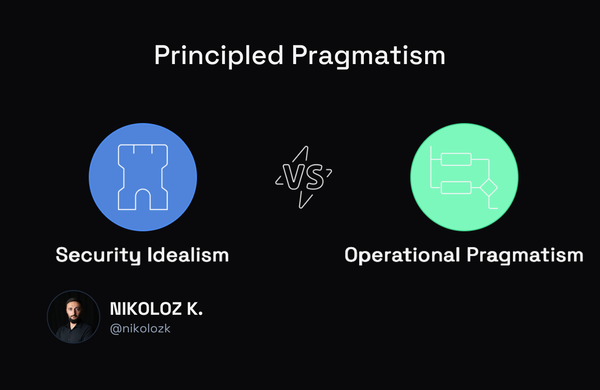CISO's Guide for Board's Buy-in on Cybersecurity

Nikoloz Kokhreidze
Ditch the fear tactics to get the board's buy-in for cybersecurity initiatives. Learn how to present cybersecurity as a growth enabler, quantify impact and more

Using fear as a primary motivator in cybersecurity discussions with your board can backfire.
While highlighting risks is important, overemphasizing them without a balanced perspective can lead to decision paralysis or skepticism.
Fear-driven narratives can create a disconnect, causing board members to view cybersecurity as a distant, abstract problem rather than an integral part of business strategy.

I'm going to show you how to effectively communicate the value of cybersecurity to your board, aligning it with business growth and strategic advantage.
Understanding how to bridge the gap between cybersecurity and business objectives is crucial. It turns security from a cost into an investment, enhancing trust and opening doors to innovation. This perspective can help convert cybersecurity into a business enabler, fostering growth and competitive edge.
Unfortunately, many fail to make this connection.
The primary reason of failing is a reliance on fear-based tactics.
- Board members often become desensitized to alarmist language.
- Cybersecurity is wrongly tagged only as a cost center, not a strategic contributor.
- There's a lack of engagement from the board due to a failure to see its business value.
- Opportunities to integrate security into the business growth plan are overlooked.
I'm going to guide you through overcoming these barriers.
Here's how, step by step:
Step 1: Frame Cybersecurity as a Growth Enabler, not Just a Protective Measure
It's crucial to demonstrate that robust cybersecurity practices can open new markets and enhance customer loyalty. Show how a breach can derail growth and how proactive security can be a selling point. For example, a company with strong security can market this to customers, assuring them their data is safe, which in turn can increase sales and customer retention.
How to do it?
- Identify core business functions and how cybersecurity supports them. For example, if payment provider needs to comply with PCI-DSS, demonstrate how cybersecurity measures are crucial for business operations.
- Develop a presentation/memo/documentation that links cybersecurity initiatives to business outcomes. Use specific scenarios, like how encryption and access controls can prevent data breaches that lead to loss of customer trust and revenue.
- Create a list of historical data breaches in your industry and their impact on business to show what robust cybersecurity can prevent. Use real-life data breaches as an example (check out Mandos Brief series to find relevant examples).
- Propose cybersecurity measures that can open new business avenues, such as entering markets with stringent data protection laws.
- Make sure to avoid IT speech and utilize business language.
Step 2: Quantify the Impact of Cybersecurity Investments
The common misstep here is vague justifications. Instead, provide clear data and case studies showing ROI from security investments. Explain how these investments protect and enhance the company's value proposition. For instance, detail how investment in security compliance opens up government contract opportunities, which can lead to new revenue streams.
How to do it?
- Conduct a cost-benefit analysis of cybersecurity investments. Calculate potential losses from data breaches versus the cost of implementing security measures.
- Gather case studies from other businesses that show the positive impact of cybersecurity on their revenue and brand reputation.
- Set clear cybersecurity KPIs aligned with business goals. For instance, measure the decrease in incident response time or the increase in compliance rates.
- Communicate these findings to your board in a clear, jargon-free manner, focusing on the return on investment for each proposed cybersecurity initiative.
Is Security Blocking Your Next Enterprise Deal?
Let's discuss how fractional CISO services can unlock your pipeline without the full-time overhead.
Step 3: Integrate Cybersecurity into Business Strategy
The light at the end of the tunnel is a resilient, forward-thinking company. When cybersecurity measures are woven into the fabric of business strategy, they drive innovation and operational efficiency. Detail the success stories of businesses that have done this, illustrating the long-term benefits and the proactive culture it fosters.
How to do it?
- Conduct workshops with key stakeholders to ensure understanding of cybersecurity's role in the business strategy.
- Collaborate with business units to embed cybersecurity practices into their workflows. For example, integrate secure coding practices into the software development lifecycle.
- Develop a phased roadmap for implementing cybersecurity measures that support business objectives, such as expanding into new markets securely. You might not necessarily need a new GRC solution, perhaps boosting your incident response capabilities or addressing audit findings can be smarter investment.
- Regularly review and update the cybersecurity strategy to keep pace with business changes and emerging threats. Present these updates in board meetings to maintain ongoing engagement.
By positioning cybersecurity as a cornerstone of your business strategy, you pave the way for sustainable growth, customer loyalty, and market leadership. Eventually this will help you get board's buy-in. Expect to see a cultural shift where the board actively participates in cybersecurity dialogues, seeing it as an indispensable part of business success. This is about creating a resilient, innovative organization that thrives not in spite of its cybersecurity posture, but because of it.
That was it for the week. See you next time!
P.S.: If this content resonates with you, consider following me on LinkedIn.
Nikoloz



